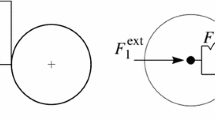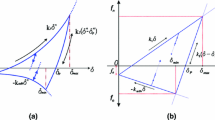Abstract
In the present work, a computational framework is established for multiscale modeling and analysis of solid propellants. A packing algorithm, considering the ammonium perchlorate (AP) and aluminum (Al) particles as spheres or discs is developed to match the size distribution and volume fraction of solid propellants. A homogenization theory is employed to compute the mean stress and strain of a representative volume element (RVE). Using the mean results, a suitable size of RVE is decided. Without considering the interfaces between particles and matrix, several numerical simulations of the relaxation of propellants are performed. The relaxation effect and the nonlinear mechanical behavior of propellants which are dependent on the applied loads are discussed. A new technology named surface-based cohesive behavior is proposed to describe the phenomenon of particle dewetting consisting of two ingredients: a damage initiation criterion and a damage evolution law. Several examples considering contact damage behavior are computed and also nonlinear behavior caused by damaged interfaces is discussed in this paper. Furthermore the effects of the critical contact stress, initial contact stiffness and contact failure distance on the damaged interface model have been studied.
Similar content being viewed by others
References
Matous K., Inglis H. M., Gu X., et al.: Multiscale damage modeling of solid propellants: theory and computational framework. AIAA 2005-4347 1–14 (2005)
Swanson S.R., Christensen L. W.: A constitutive formulation for high-elongation propellants. Journal of Spacecraft. 20(6), 559–566 (1983)
Francis, E.C., Thompson, R.E.: Nonlinear structural modeling of solid propellants. In: Proceedings of the AIAA/SAE/ASME Joint Propulsion Conference. AIAA 1984, New York, 1–5
Schapery R.A.: Analysis of damage growth in particulate composites using a work potential. Composites Engineering. 1(3), 167–182 (1991)
Park S.W., Schapery R.A.: A viscoelastic constitutive model for particulate composites with growing damage. International Journal of Solids and Structures. 34(8), 931–947 (1997)
Ha, K., Schapery, R.A.: A three-dimensional viscoelastic constitutive model for particulate composites with growing damage and its experimental validation. International Journal of Solids and Structures. 35, 3497–3517 (1998)
Ozupek S.: Constitutive equations for solid propellants. [Ph.D. Thesis]. University of Texas at Austin. 1–111 (1997)
Jung, G.D., Youn, S.K., Kim, B.K.: A three-dimensional nonlinear viscoelastic constitutive model of solid propellant. International Journal of Solids and Structures. 37(34), 4715–4732 (2000)
Wong F.C., Levesque D.: Prediction and characterization of orthotropic properties of damaged particulate composites. AIAA-99-2642 1–8 (1999)
Ho, S.K.: High strain-rate constitutive models for solid rocket propellant. Journal of Propulsion and Power. 18(5) 1106–1112 (2002)
Hinterhoelzl, R.M., Schapery, R.A.: FEM implementation of a three-dimensional viscoelastic constitutive model for particulate composites with damage growth. Mechanics of Time-Dependent Materials. 8, 65–94 (2004)
Kunz, R.K.: Continuum damage mechanics modeling of solid propellant. AIAA 2008-4973 1–9 (2008)
Kunz, R.K.: Characterization of solid propellant for linear cumulative damage modeling. AIAA 2009-5257 1–10 (2009)
Xu, F., Aravas, N., Sofronis, P.: Constitutive modeling of solid propellant materials with evolving microstructural damage. Journal of the Mechanics and Physics of Solids. 56, 2050–2073 (2008)
Michel, J.C., Moulinec, H., Suquet, P.: Effective properties of composite materials with periodic microstructure: a computational approach. Computer Methods in AppliedMechanics and Engineering. 172(1–4), 109–143 (1999)
Llorca, J., Segurado, J.: Three-dimensional multipartical cell simulations of deformation and damage in sphere-reinforced composites. Materials Science and Engineering. A365, 267–274 (2004)
Tan, H., Liu, C., Huang, Y., et al.: The cohesive law for the particle/matrix interfaces in high explosives. Journal of the Mechanics and Physics of Solids. 53, 1892–1917 (2005)
Mori, T., Tanaka, K.: Average stress in matrix and average elastic energy of materials with misfitting inclusions. Acta Metall. 21 571–574 (1973)
Tan, H., Huang, Y., Liu, C., et al.: TheMori-Tanaka method for composite materials with nonlinear interface debonding. International Journal of Solids and Structures. 21 1890–1918 (2005)
Tan, H., Huang, Y., Liu, C.: The uniaxial tension of particulate composite materials with nonlinear interface debonding. International Journal of Solids and Structures. 44, 1809–1822 (2007)
Matous, K., Geubelle, P.H.: Multiscale modeling of particles debonding in reinforced elastomers subjected to finite deformations. International Journal for Numerical Methods in Engineering. 65(2), 190–223 (2006)
Buckmaster, J., Jackon, T.L., Hegab, A., et al.: Randomly packed heterogeneous propellants and the flames they support. AIAA 2001-0337 1–25 (2001)
Knott, G.M., Jackson, T.L., Buckmaster, J.: Random packing of heterogeneous propellants. AIAA Journal. 39(4), 678–687 (2001)
Gitman, I.M., Askes, H., Sluys, L.J.: Representative volume: Existence and size determination. Engineering Fracture Mechanics. 74, 2518–2534 (2007)
Drugan, W.J., Willis, J.R.: A micromechanics-based nonlocal constitutive equation and estimates of representative volume element size for elastic composites. J. Mech. Phys. Solids. 44(4), 497–524 (1996)
Fluctuations, E. P.: Correlations and representative elementary volume (REV) in granular materials. Poudres Grains. 11, 6–17 (2000)
Zhao, J.L.: Mechanics damage and meso numerical simulation of evolvement processing research for composite solid propellant. [Ph.D. Thesis]. Second Artillery Engineering University. (2010)
Author information
Authors and Affiliations
Corresponding author
Rights and permissions
About this article
Cite this article
Zhi, SJ., Sun, B. & Zhang, JW. Multiscale modeling of heterogeneous propellants from particle packing to grain failure using a surface-based cohesive approach. Acta Mech Sin 28, 746–759 (2012). https://doi.org/10.1007/s10409-012-0058-y
Received:
Revised:
Accepted:
Published:
Issue Date:
DOI: https://doi.org/10.1007/s10409-012-0058-y




